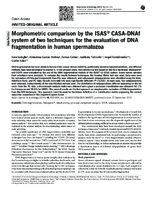Morphometric comparison by the ISAS® CASA-DNAf system of two techniques for the evaluation of DNA fragmentation in human spermatozoa

Fecha
2016Autor
Sadeghi, Sara
García‑Molina, Almudena
Celma, Ferran
Fereidounfar, Sogol
Soler, Carles
Valverde-Abarca, Anthony
Metadatos
Mostrar el registro completo del ítemResumen
DNA fragmentation has been shown to be one of the causes of male infertility, particularly related to repeated abortions, and different methods have been developed to analyze it. In the present study, two commercial kits based on the SCD technique (Halosperm ® and SDFA) were evaluated by the use of the DNA fragmentation module of the ISAS ® v1 CASA system. Seven semen samples from volunteers were analyzed. To compare the results between techniques, the Kruskal-Wallis test was used. Data were used for calculation of Principal Components (two PCs were obtained), and subsequent subpopulations were identified using the Halo, Halo/Core Ratio, and PC data. Results from both kits were significantly different (P < 0.001). In each case, four subpopulations were obtained, independently of the classification method used. The distribution of subpopulations differed depending on the kit used. From the PC data, a discriminant analysis matrix was obtained and a good a posteriori classification was obtained (97.1% for Halosperm and 96.6% for SDFA). The present results are the first approach on morphometric evaluation of DNA fragmentation from the SCD technique. This approach could be used for the future definition of a classification matrix surpassing the current subjective evaluation of this important sperm factor.
Descripción
Artículo científico
Fuente
Asian Journal of AndrologyCompartir
Métricas
Colecciones
- Artículos [26]

